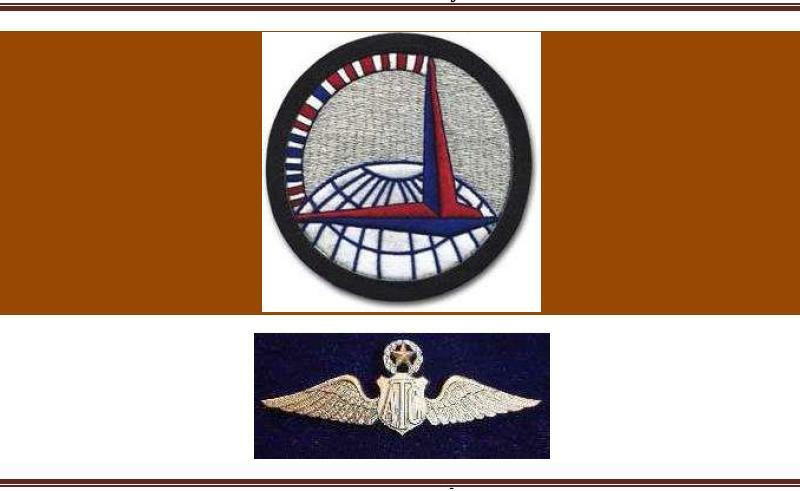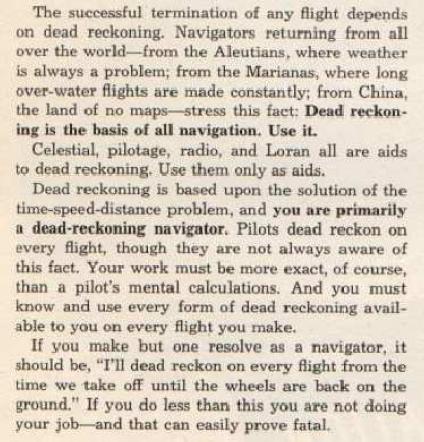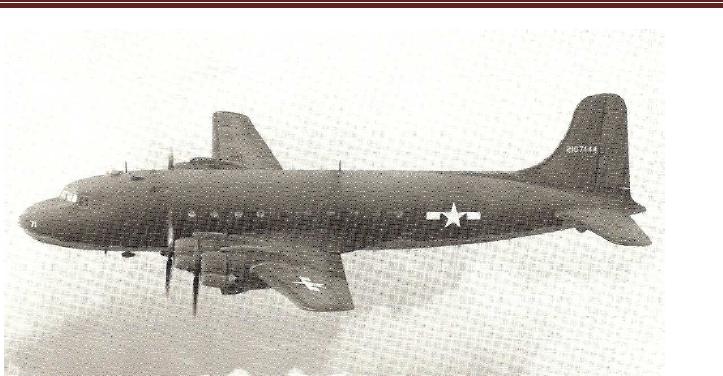
When the Second World War began, the Air Transport Command (ATC) did not
exist. Worse, when the United States went to war with Japan and Germany in
December 1941, not a single airplane specifically designed for cargo
transport was in the US fleet. For the staggering new needs of the military,
therefore, the Army Air Forces had to convert all manner of their own
bombers (e.g. the B-24 Liberator into the C-87), and requisition passenger
aircraft from the civilian air line companies. The DC-3, modified to the
C-47, and the DC-4, modified to the C-54 (see photos below), both played a
significant role in the ATC. Other planes in use by the commercial air
lines, and available for military service, included TWA’s fleet of Boeing
Stratoliners, Pan American’s Boeing B314 Clippers, a number of Lockheed
Lodestars, Sikorsky Flying Boats, Boeing 247s, DC-2s, Lockheed L10s, and
Martin Flying Boats.
The route system that ATC developed included the North Atlantic Route, the
South Atlantic Route, Central Pacific Airways, South Pacific Airways,
Southwest Pacific Airways, African Air Routes, China-Burma-India Airway, and
Air Routes to Alaska.
This installment of flights includes the North Atlantic Routes, as shown in
the chart above. Best of all, more ATC Routes are on the way.
The North Atlantic Routes comprises six individual routes with a total of 17
flights. These are numbered NA01 to NA17. Because of the distances involved,
C-47s are recommended for some flights while C54s are required for others.
The flight descriptions identify which aircraft should be used for each.
Navigational aids were sparse or non-existent at the start of the war.
Basically, all that was available for navigation was dead reckoning and a
few radio stations (including radio range) and weather stations that could
be used for homing, plus celestial navigation. However, dead reckoning was
the primary means of navigation during the war as can be seen from the
following excerpt from the World War II Army Air Forces Collection,
Navigators’ Information File (NIF), July 1945, which can be downloaded from
here.



In addition to the scarcity of navigation aids, the weather compounded the
difficulty of flying these routes with abundant occurrences of wind, fog,
clouds, rain, snow and ice.
For the greatest realism, set your flight-sim weather to the actual weather
when flying these flights.
The flight altitudes used are approximately 7500 feet for the C-47 and
10,500 feet for the C-54, except where higher altitudes are required to
clear mountains. However, it should be noted that the pilots flying these
routes had the flexibility to avoid severe weather by flying above, below
(sometimes at 500 ft over the ocean), or at any altitude in between
necessary to safely navigate to their destinations and make safe landings.
There was virtually no air traffic control for these routes during this
period. Therefore, pilots are encouraged to fly at the altitude which will
result in a safe and successful trip.
Note that cancelling a flight or turning back to the airport of origin or
going to an alternate airport were options that were often used by the ATC
pilots when unacceptably bad weather was forecast or encountered en route.
Pilots are encouraged to use C-47s and C-54s having textures of the AAF.
They can be found at www.fsplanet.com, www.simviation.com, www.avsim.com,
and other flight-sim archives. This will add a further touch of realism and
will increase the enjoyment of these flights. Of course, the excellent DC-3s
and DC-4 provided by DC-3 Airways can also be used.
When you view the download, you will see that Guy Goddard, DCA-1447, has put
a huge amount of research and work into this route system. The description
above is excerpted from his narrative in the download, where you will also
find the flight descriptions, FSN files, a high-resolution chart suitable
for printing, and route summaries. He nicely finishes off the narrative with
references pertaining to the WWII state of the art of meteorology as well as
references for period radio navigation and air navigation. For those who
thirst for more, a worthy recommended reading list is also included.
Those who have read Ernie Gann's Fate is the Hunter (an excellent read) will
find a certain familiarity in these flights. We hope you enjoy them.